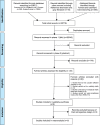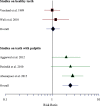Volume of Anesthetic Agents and IANB Success: A Systematic Review
- PMID: 29509518
- PMCID: PMC5841477
- DOI: 10.2344/anpr-65-01-03
Volume of Anesthetic Agents and IANB Success: A Systematic Review
Abstract
The aim of this study was to provide an evidence-based answer to the question: "Is 3.6-mL volume of an anesthetic agent more effective than 1.8-mL volume in providing anesthesia for mandibular molars?" Following formulation of research question and keyword selection, a comprehensive search of the following databases was conducted: Cochrane library, PubMed, Scopus, Google Scholar, ProQuest, and Clinicaltrials.gov. Three-phase eligibility appraisal and quality assessment of the studies were carried out by 2 independent reviewers. To reduce clinical heterogeneity, the included studies were divided into 2 groups: studies on healthy teeth and studies on teeth with pulpitis. The data of included studies were statistically combined through meta-analysis using a fixed-effects model. A total of 20,778 records were initially retrieved from the search. Following screening and eligibility assessment, 8 studies met the eligibility criteria and were included for qualitative synthesis. Of those, 5 studies were qualified for meta-analysis. In the irreversible pulpitis group, increasing the volume of anesthetic agent from 1.8 to 3.6 mL significantly increased the success rate of inferior alveolar nerve block (risk ratio = 2.45, 95% CI: 1.67-3.59, p < .001). However, there was insufficient evidence to draw a conclusion regarding healthy teeth.
Keywords: Anesthetic success; Anesthetic volume; Inferior alveolar nerve block; Mandibular molar; Meta-analysis; Systematic review.
Figures
Similar articles
-
Effect of Precooling the Anesthetic Agent in Comparison to Increasing the Dosage on the Success Rate of Inferior Alveolar Nerve Block Using Articaine in Mandibular First Molars with Symptomatic Irreversible Pulpitis: A Double-Blind, Randomized, Controlled Clinical Trial.J Endod. 2025 Aug;51(8):989-995. doi: 10.1016/j.joen.2025.05.011. Epub 2025 May 28. J Endod. 2025. PMID: 40447259 Clinical Trial.
-
Articaine buccal infiltration for mandibular first molars with symptomatic irreversible pulpitis: is it as effective as inferior alveolar nerve block with lidocaine? a systematic review and meta-analysis.Clin Oral Investig. 2025 Feb 21;29(3):146. doi: 10.1007/s00784-025-06229-0. Clin Oral Investig. 2025. PMID: 39982504
-
Effect of Nonsteroidal Anti-inflammatory Drug as an Oral Premedication on the Anesthetic Success of Inferior Alveolar Nerve Block in Treatment of Irreversible Pulpitis: A Systematic Review with Meta-analysis and Trial Sequential Analysis.J Endod. 2018 Jun;44(6):914-922.e2. doi: 10.1016/j.joen.2018.02.017. Epub 2018 Apr 27. J Endod. 2018. PMID: 29709297
-
Efficacy of local anaesthetic solutions on the success of inferior alveolar nerve block in patients with irreversible pulpitis: a systematic review and network meta-analysis of randomized clinical trials.Int Endod J. 2019 Jun;52(6):779-789. doi: 10.1111/iej.13072. Epub 2019 Feb 12. Int Endod J. 2019. PMID: 30638269
-
EFFICACY OF 4% ARTICAINE BUCCAL INFILTRATION VERSUS INFERIOR ALVEOLAR NERVE BLOCK FOR MANDIBULAR MOLARS WITH SYMPTOMATIC IRREVERSIBLE PULPITIS: A SYSTEMATIC REVIEW AND META-ANALYSIS.J Evid Based Dent Pract. 2022 Jun;22(2):101712. doi: 10.1016/j.jebdp.2022.101712. Epub 2022 Mar 6. J Evid Based Dent Pract. 2022. PMID: 35718426
Cited by
-
Effectiveness of different anesthetic methods for mandibular posterior teeth with symptomatic irreversible pulpitis: a systematic review and meta-analysis.Clin Oral Investig. 2021 Dec;25(12):6477-6500. doi: 10.1007/s00784-021-04145-7. Epub 2021 Aug 28. Clin Oral Investig. 2021. PMID: 34453595
-
Comparative evaluation of anesthetic efficacy of 1.8 mL and 3.6 mL of articaine in irreversible pulpitis of the mandibular molar: A randomized clinical trial.PLoS One. 2019 Jul 31;14(7):e0219536. doi: 10.1371/journal.pone.0219536. eCollection 2019. PLoS One. 2019. PMID: 31365529 Free PMC article. Clinical Trial.
-
Comparative evaluation of ropivacaine and lidocaine as dental pulp anaesthesia.Bioinformation. 2021 Jan 31;17(1):229-239. doi: 10.6026/97320630017229. eCollection 2021. Bioinformation. 2021. PMID: 34393442 Free PMC article.
-
Application of ultrasound guidance in the oral and maxillofacial nerve block.PeerJ. 2021 Nov 26;9:e12543. doi: 10.7717/peerj.12543. eCollection 2021. PeerJ. 2021. PMID: 34900442 Free PMC article.
-
Comparative evaluation of anesthetic efficacy of warm, buffered and conventional 2% lignocaine for the success of inferior alveolar nerve block (IANB) in mandibular primary molars: A randomized controlled clinical trial.J Dent Res Dent Clin Dent Prospects. 2018 Spring;12(2):102-109. doi: 10.15171/joddd.2018.016. Epub 2018 Jun 20. J Dent Res Dent Clin Dent Prospects. 2018. PMID: 30087760 Free PMC article.
References
-
- Kanaa MD, Whitworth JM, Corbett IP, Meechan JG. . Articaine buccal infiltration enhances the effectiveness of lidocaine inferior alveolar nerve block. Int Endod J. 2009; 42: 238– 246. - PubMed
-
- Kaufman E, Weinstein P, Milgrom P. . Difficulties in achieving local anesthesia. J Am Dent Assoc. 1984; 108: 205– 208. - PubMed
-
- Nusstein J, Reader A, Beck FM. . Anesthetic efficacy of different volumes of lidocaine with epinephrine for inferior alveolar nerve blocks. Gen Dent. 2002; 50: 372– 375; quiz 376–377. - PubMed
-
- Yonchak T, Reader A, Beck M, Meyers WJ. . Anesthetic efficacy of unilateral and bilateral inferior alveolar nerve blocks to determine cross innervation in anterior teeth. Oral Surg Oral Med Oral Pathol Oral Radiol Endod. 2001; 92: 132– 135. - PubMed
-
- Aggarwal V, Singla M, Miglani S, Kohli S, Singh S. . Comparative evaluation of 1.8 mL and 3.6 mL of 2% lidocaine with 1:200,000 epinephrine for inferior alveolar nerve block in patients with irreversible pulpitis: a prospective, randomized single-blind study. J Endod. 2012; 38: 753– 756. - PubMed
Publication types
MeSH terms
Substances
LinkOut - more resources
Full Text Sources
Other Literature Sources
Miscellaneous



